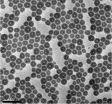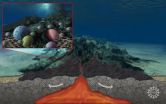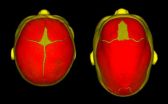(Press-News.org) HOUSTON -- (Nov. 19, 2012) -- Serendipity proved to be a key ingredient for the latest nanoparticles discovered at Rice University. The new "lava dot" particles were discovered accidentally when researchers stumbled upon a way of using molten droplets of metal salt to make hollow, coated versions of a nanotech staple called quantum dots.
The results appear online this week in the journal Nanotechnology. The researchers also found that lava dots arrange themselves in evenly spaced patterns on flat surfaces, thanks in part to a soft outer coating that can alter its shape when the particles are tightly packed.
"We're exploring potential of using these particles as catalysts for hydrogen production, as chemical sensors and as components in solar cells, but the main point of this paper is how we make these materials," said co-author Michael Wong, professor of chemical and biomolecular engineering at Rice. "We came up with this 'molten-droplet synthesis' technique and found we can use the same process to make hollow nano-size particles out of several kinds of elements. The upshot is that this discovery is about a whole family of particles rather than one specific composition."
Like their quantum dot cousins, Rice's lava dots can be made of semiconductors like cadmium selenide and zinc sulfide.
Wong's lab has been working steadily to improve the synthesis of quantum dots for more than five years. In 2007, Wong's team discovered a cleaner and cheaper way to synthesize four-legged quantum dots -- particles smaller than a living cell that look like tiny versions of children's jacks. These "nanojacks," which are also called quantum tetrapods, can be used to harvest sunlight in a revolutionary new kind of solar panel.
The key step in the 2007 discovery was the use of a surfactant called CTAB. In 2010 Rice graduate student Sravani Gullapalli was attempting to refine the "nanojack" synthesis even further when she discovered lava dots.
"This new chemistry to make the tetrapods was fairly cheap, but we were looking for an even cheaper way," Wong said. "Sravani said, 'Let's get rid of this expensive phosphorus surfactant and just see what happens.' So she did, and these little things just popped out on the electron microscope screen."
Wong recalled the team's initial surprise. "We said, 'What is going on here? How do you go from four-legged nanojacks to these little balls?'"
He said it took the team more than a year to decipher the unusual formation mechanism that yielded the hollow, soft-shelled particles.
To make the particles, Gullapalli added three kinds of solid powder -- cadmium nitrate, selenium and a tiny amount of CTAB -- to an oil solvent. She then slowly heated the mixture while stirring. The cadmium nitrate melted first and formed tiny nanodroplets that cannot be seen with the naked eye.
"Nothing happens until the temperature continues to rise and the selenium melts," Gullapalli said. "The molten selenium then wraps around the cadmium nitrate droplet, and the cadmium nitrate diffuses out and leaves a hole where the droplet once was."
She said the cadmium selenide shell surrounding the hole is nanocrystalline and is enveloped in a soft outer shell of pure selenium.
When Gullapalli examined the lava dots with a transmission electron microscope, she found them to be bigger than standard quantum dots, about 15-20 nanometers in diameter. The holes were about 4-5 nanometers in diameter. She also noticed something peculiar: When sitting by themselves they appeared round, and when tightly packed, the shell appeared to become compressed, even though neighboring dots never came into actual contact with one another.
"That's one of the twists to this weird chemistry," Wong said. "The solvent forms its own surfactant during this process. The surfactant coats the particles and keeps them from touching each other, even when they are tightly packed together."
Wong's team later found it could use the molten droplet method to make lava dots out of zinc sulfide, cadmium sulfide and zinc selenide.
"We found that the hollow particles met and even exceeded some performance metrics of quantum dots in a solar-cell test device, and we're continuing to examine how these might be useful," Gullapalli said.
INFORMATION:
Additional co-authors include former Rice undergraduate Jason Grider '12; Rice graduate student Minjung Cho; former Rice postdoctoral researcher Hitesh Bagaria; Kyu-Sung Lee of Arizona State University; Vicki Colvin, Rice's vice provost for research and the Kenneth S. Pitzer-Schlumberger Professor of Chemistry; and Ghassan Jabbour, director of the Solar and Alternative Energy Engineering Research Center at Saudi Arabia's King Abdullah University of Science and Technology.
The research was supported by the Shell Center of Sustainability at Rice University and SABIC Americas.
High-resolution images are available for download at:
http://news.rice.edu/wp-content/uploads/2012/11/1130_LAVA-dots-lg.jpg
CAPTION: Rice University scientists discovered "lava dots," a new type of nanoparticle that is made using molten droplets of metal salt. Lava dots are hollow, coated versions of a nanotech staple called quantum dots.
CREDIT: S. Gullapalli/Rice University
http://news.rice.edu/wp-content/uploads/2012/11/1130_LAVA-diagram-lg.jpg
CAPTION: When sitting by themselves, lava dots appear round, but their soft outer shells flatten when they are packed near one another.
CREDIT: S. Gullapalli/Rice University
http://news.rice.edu/wp-content/uploads/2012/11/1130_LAVA-crop-lg.jpg
CAPTION: A nine-pack of lava dots
CREDIT: S. Gullapalli/Rice University
The Nanotechnology paper is available at:
http://iopscience.iop.org/0957-4484/23/49/495605
This release can be found online at news.rice.edu.
Follow Rice News and Media Relations via Twitter @RiceUNews
MEDIA CONTACTS:
Jeff Falk
713-348-6775
jfalk@rice.edu
Mike Williams
713-348-6728
mikewilliams@rice.edu
Lava dots: Rice makes hollow, soft-shelled quantum dots
Investigation of quantum dots leads to new particles formed by molten droplets
2012-11-20
ELSE PRESS RELEASES FROM THIS DATE:
Kessler Foundation researchers predict hidden epidemic of neurological disability for India
2012-11-20
West Orange, NJ. November 19, 2012. The 'Global Perspectives' published in the Nov. 20, 2012 issue of Neurology®, the medical journal of the American Academy of Neurology, features "Neurologic Disability: A Hidden Epidemic for India". The authors, a team of US and Indian scientists, detail three emerging trends contributing to this public heath problem and outline measures to stem its growth. Abhijit Das, MD, DM, Amanda Botticello, PhD, MPH, and Glenn Wylie, DPhil, are researchers at Kessler Foundation in West Orange, New Jersey. Kurupath Radhakrishnan, MD, DM, FAAN, is ...
Yeast protein breaks up amyloid fibrils and disease protein clumps differently
2012-11-20
PHILADELPHIA — Several fatal brain disorders, including Parkinson's disease, are connected by the misfolding of specific proteins into disordered clumps and stable, insoluble fibrils called amyloid. Amyloid fibrils are hard to break up due to their stable, ordered structure. For example, α-synuclein forms amyloid fibrils that accumulate in Lewy Bodies in Parkinson's disease. By contrast, protein clumps that accumulate in response to environmental stress, such as heat shock, possess a less stable, disordered architecture.
Hsp104, an enzyme from yeast, breaks up both ...
New study review examines benefits of music therapy for surgery patients
2012-11-20
LEXINGTON, Ky. (Nov. 19, 2012) — A new study review published by the University of Kentucky found that music therapy can be beneficial to patients before, during and after a surgical procedure and may reduce pain and recovery time.
Published in the Southern Medical Journal, the review examined the use of music in the preoperative, intraoperative and postoperative stages of the surgical process, and music was shown to have positive results in all three stages. Patients were less anxious before the procedure and recovered more quickly and satisfactorily after by being exposed ...
'Dark Energy': Life beneath the seafloor discussed at upcoming American Geophysical Union conference
2012-11-20
"Who in his wildest dreams could have imagined that, beneath the crust of our Earth, there could exist a real ocean...a sea that has given shelter to species unknown?"
So wrote Jules Verne almost 150 years ago in A Journey to the Center of the Earth. Verne probably couldn't have imagined the diversity of life that researchers observe today under the ocean floor.
Scientists affiliated with the National Science Foundation (NSF) Center for Dark Energy Biosphere Investigations (C-DEBI) will discuss recent progress in understanding life beneath the seafloor at the American ...
Seattle Children's Research Institute helps identify causes of sagittal craniosynostosis
2012-11-20
Seattle Children's Research Institute, together with an international team of scientists and clinicians from 22 other institutions, have identified two genetic risk factors for the most common form of non-syndromic craniosynostosis, a birth defect in which the bony plates of an infant's skull prematurely fuse. The condition is known as sagittal craniosynostosis and often results in an abnormal head shape and facial features.
The study identified two genes (BMP2 and BBS9) associated with sagittal craniosynostosis that are known to be involved in broader skeletal development.
Results ...
Martian history: Finding a common denominator with Earth's
2012-11-20
Washington, DC — A team of scientists, including Carnegie's Conel Alexander and Jianhua Wang, studied the hydrogen in water from the Martian interior and found that Mars formed from similar building blocks to that of Earth, but that there were differences in the later evolution of the two planets. This implies that terrestrial planets, including Earth, have similar water sources--chondritic meteorites. However, unlike on Earth, Martian rocks that contain atmospheric volatiles such as water, do not get recycled into the planet's deep interior. Their work will be published ...
Faulty development of immature brain cells causes hydrocephalus
2012-11-20
Researchers at the University of Iowa have discovered a new cause of hydrocephalus, a devastating neurological disorder that affects between one and three of every 1,000 babies born. Working in mice, the researchers identified a cell signaling defect, which disrupts immature brain cells involved in normal brain development. By bypassing the defect with a drug treatment, the team was able to correct one aspect of the cells' development and reduce the severity of the hydrocephalus. The findings were published online Nov. 18 in the journal Nature Medicine.
"Our findings ...
CCNY landscape architect offers storm surge defense alternatives
2012-11-20
The flooding in New York and New Jersey caused by Superstorm Sandy prompted calls from Gov. Andrew Cuomo and other officials to consider building storm surge barriers to protect Lower Manhattan from future catastrophes. But, such a strategy could make things even worse for outlying areas that were hit hard by the hurricane, such as Staten Island, the New Jersey Shore and Long Island's South Shore, a City College of New York landscape architecture professor warns.
"If you mitigate to protect Lower Manhattan, you increase the impact in other areas," says Catherine Seavitt ...
New tumor tracking technique may improve outcomes for lung cancer patients
2012-11-20
PHILADELPHIA— Medical physicists at Thomas Jefferson University and Jefferson's Kimmel Cancer Center are one step closer to bringing a new tumor-tracking technique into the clinic that delivers higher levels of radiation to moving tumors, while sparing healthy tissue in lung cancer patients.
Evidence has shown a survival advantage for lung cancer patients treated with higher doses of radiation. Therefore, there is an increased interest to find novel ways to better track tumors—which are in constant motion because of breathing—in order to up the dosage during radiation ...
Multiple sclerosis 'immune exchange' between brain and blood is uncovered
2012-11-20
DNA sequences obtained from a handful of patients with multiple sclerosis at the University of California, San Francisco (UCSF) Medical Center have revealed the existence of an "immune exchange" that allows the disease-causing cells to move in and out of the brain.
The cells in question, obtained from spinal fluid and blood samples, are called B cells, which normally help to clear foreign infections from the body but sometimes react strongly with the body itself. One of the current theories of multiple sclerosis, which strikes hundreds of thousands of Americans and millions ...
LAST 30 PRESS RELEASES:
Making lighter work of calculating fluid and heat flow
Normalizing blood sugar can halve heart attack risk
Lowering blood sugar cuts heart attack risk in people with prediabetes
Study links genetic variants to risk of blinding eye disease in premature infants
Non-opioid ‘pain sponge’ therapy halts cartilage degeneration and relieves chronic pain
AI can pick up cultural values by mimicking how kids learn
China’s ecological redlines offer fast track to 30 x 30 global conservation goal
Invisible indoor threats: emerging household contaminants and their growing risks to human health
Adding antibody treatment to chemo boosts outcomes for children with rare cancer
Germline pathogenic variants among women without a history of breast cancer
Tanning beds triple melanoma risk, potentially causing broad DNA damage
Unique bond identified as key to viral infection speed
Indoor tanning makes youthful skin much older on a genetic level
Mouse model sheds new light on the causes and potential solutions to human GI problems linked to muscular dystrophy
The Journal of Nuclear Medicine ahead-of-print tip sheet: December 12, 2025
Smarter tools for peering into the microscopic world
Applications open for funding to conduct research in the Kinsey Institute archives
Global measure underestimates the severity of food insecurity
Child survivors of critical illness are missing out on timely follow up care
Risk-based vs annual breast cancer screening / the WISDOM randomized clinical trial
University of Toronto launches Electric Vehicle Innovation Ontario to accelerate advanced EV technologies and build Canada’s innovation advantage
Early relapse predicts poor outcomes in aggressive blood cancer
American College of Lifestyle Medicine applauds two CMS models aligned with lifestyle medicine practice and reimbursement
Clinical trial finds cannabis use not a barrier to quitting nicotine vaping
Supplemental nutrition assistance program policies and food insecurity
Switching immune cells to “night mode” could limit damage after a heart attack, study suggests
URI-based Global RIghts Project report spotlights continued troubling trends in worldwide inhumane treatment
Neutrophils are less aggressive at night, explaining why nighttime heart attacks cause less damage than daytime events
Menopausal hormone therapy may not pose breast cancer risk for women with BRCA mutations
Mobile health tool may improve quality of life for adolescent and young adult breast cancer survivors
[Press-News.org] Lava dots: Rice makes hollow, soft-shelled quantum dotsInvestigation of quantum dots leads to new particles formed by molten droplets



